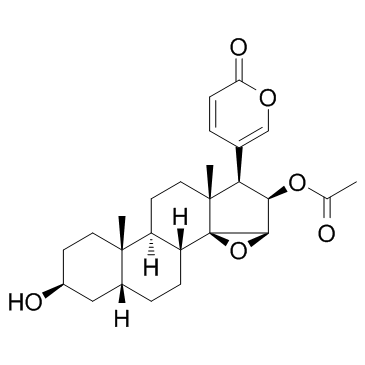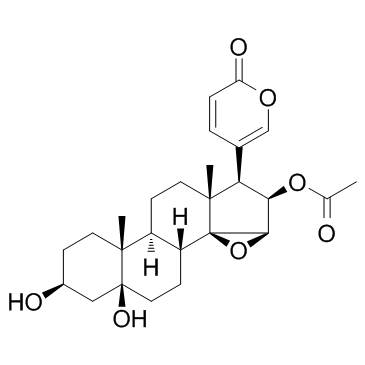470-37-1
| Name | Cinobufagin |
|---|---|
| Synonyms |
Bufa-20,22-dienolide, 16-(acetyloxy)-14,15-epoxy-3-hydroxy-, (3β,5β,15β,16β)-
(3β,5β,15β,16β)-16-Acetoxy-3-hydroxy-14,15-epoxybufa-20,22-dienolide 5β-Bufa-20,22-dienolide, 14,15β-epoxy-3β,16β-dihydroxy-, 16-acetate (8CI) cinobufagine Bufa-20,22-dienolide, 16- (acetyloxy)-14,15-epoxy-3-hydroxy-, (3β,5β,15β,16β)- CINOBUFAGIN(P) UNII:T9PSN4R8IR 5β-Bufa-20,22-dienolide, 14,15β-epoxy-3β,16β-dihydroxy-, 16-acetate MFCD00056825 RARECHEM BK HC T302 Cinobufagin (3β,5β,15β,16β)-16-(acetyloxy)-3-hydroxy-14,15-epoxybufa-20,22-dienolide |
| Description | Cinobufagin, a kind of Chinese materia medica with antitumor effect, is widely used in clinical practice, especially in anti-liver cancer.IC50 value:Target:In vitro: Cinobufagin inhibited proliferation of cancer cells at doses of 0.1, 1, or 10 μM after 2–4 days of culture. Cytotoxicity of cinobufagin on the DU145 and LNCaP cells was dose-dependent. Cinobufagin increased [Ca2+]i and apoptosis in cancer cells after a 24-hr culture as well as caspase 3 activities in DU145 and PC3 cells and caspase 9 activities in LNCaP cells [1]. Cinobufagin suppresses cell proliferation and causees apoptosis in prostate cancer cells via a sequence of apoptotic modulators, including Bax, cytochrome c and caspases [2].In vivo: |
|---|---|
| Related Catalog | |
| References |
| Density | 1.3±0.1 g/cm3 |
|---|---|
| Boiling Point | 595.4±50.0 °C at 760 mmHg |
| Melting Point | 222-223ºC |
| Molecular Formula | C26H34O6 |
| Molecular Weight | 442.545 |
| Flash Point | 199.4±23.6 °C |
| Exact Mass | 442.235535 |
| PSA | 89.27000 |
| LogP | 2.43 |
| Vapour Pressure | 0.0±3.8 mmHg at 25°C |
| Index of Refraction | 1.595 |
| Storage condition | 2-8°C |
CHEMICAL IDENTIFICATION
HEALTH HAZARD DATAACUTE TOXICITY DATA
|
| Symbol |

GHS06 |
|---|---|
| Signal Word | Danger |
| Hazard Statements | H300-H310-H330 |
| Precautionary Statements | P260-P264-P280-P284-P302 + P350-P310 |
| Personal Protective Equipment | Eyeshields;Faceshields;full-face particle respirator type N100 (US);Gloves;respirator cartridge type N100 (US);type P1 (EN143) respirator filter;type P3 (EN 143) respirator cartridges |
| Hazard Codes | T+: Very toxic; |
| Risk Phrases | R26/27/28 |
| Safety Phrases | S22-S36/37/39-S45 |
| RIDADR | UN 2811 |
| WGK Germany | 3 |
| RTECS | GD7850000 |
| Packaging Group | II |
| Hazard Class | 6.1(a) |
| HS Code | 3001200090 |
| Precursor 0 | |
|---|---|
| DownStream 1 | |
| HS Code | 3001200090 |
|---|



